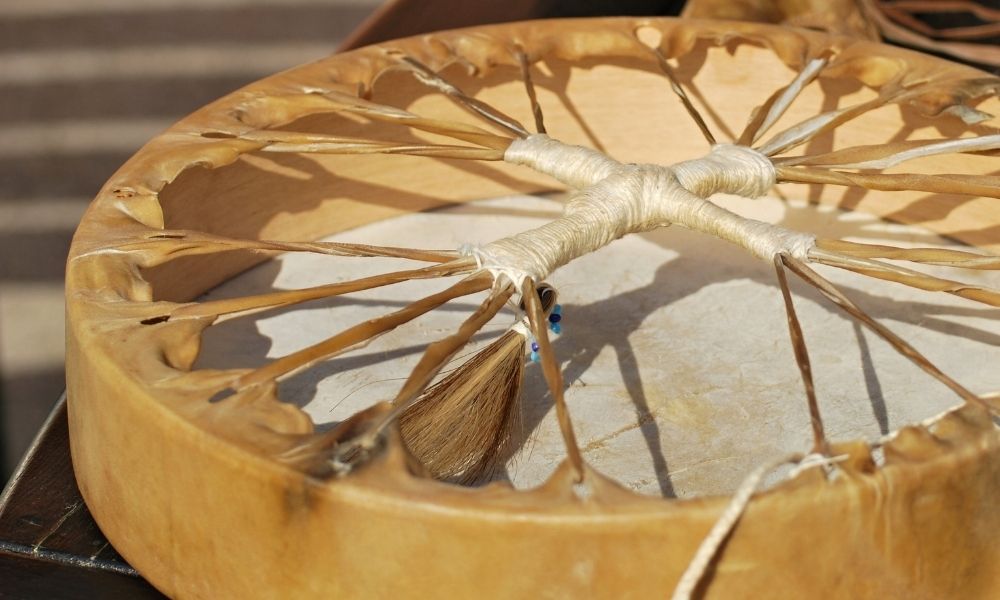Top Authentic Native American Drum Accessories
Native American drums are sac..
 ">
">Drums, whether they’re smaller hand drums or larger powwow drums, have played a predominant role in the culture of many Native American tribes for centuries. People use them to bring communities together, connect with the Creator and other influential spirits, heal the body and mind of sick individuals, and so much more. The shaman drum is one type of drum with a rich history and great importance to tribes such as the Tarahumara. In this comprehensive guide, we’ll explain how shaman drums have influenced Native American culture, how they’re made, and why people use them, among other things.
People occasionally refer to the shaman drum as a spirit drum or heart drum, names that may reference how they help connect people with the spirits and the heartbeat of Mother Earth. People make these drums by stretching animal hide—elk, buffalo, moose, horse, and goat are common choices—over a wooden frame. Then, they lace the head to the frame in a symbolic pattern that represents the four directions of the earth. This has a spiritual meaning, but it also serves a practical purpose—it provides drummers with a suitable grip. A shaman’s drum might also contain metal objects dangling from the lacing. It’s not uncommon for another shaman to bless the newly made shaman drums to imbue them with potent spiritual qualities.
Shaman drums are traditionally one-sided drums, which means that the rawhide only stretches over one side. You can play them with a drum beater or your hands. Shamans may also use a special shamanic rattle to beat their drums. You can also adjust the lace on the underside of the drum to alter the sound that it produces.
Where do shaman drums get their name, you might wonder? Shamans, more accurately described as “medicine people” or “ceremonial people,” are spiritual healers that serve their respective communities. People believe them to have the power to heal human illnesses, interpret dreams, connect with the spirit world, and influence elements such as the weather, the outcome of contests, crop yields, and more. Many shamans hold positions of great authority in their communities. They often serve as spiritual leaders, doctors, and counselors.
There are many different ways in which shamans can attempt to interact with the spirit world, but one of the most common methods is through shamanic drumming. The most prominent way that shaman drums have influenced Native American culture is by offering a means for Native American holy people to perform their rituals. The deep, steady rhythm of the drum is said to draw the shaman into a trance-like state. While in this altered state of consciousness, the shaman functions as an intermediary between the natural and spirit worlds. They can move spirits or spiritual energies from the spirit world to the natural world, where they can be used for mending physical or emotional wounds or for other purposes.
During these shamanic rituals, they may use bells or rattles. These can purify the space in which the ritual is being performed, or call or send back spirits from the spirit world.
Crucially, not all Native American people approve of the use of the terms “shaman” and “shamanism,” although others have come to embrace them. The word shaman originated in Siberia, where people used it to describe a certain type of holy person. Most Native American tribes will instead refer to their holy people as medicine people, spiritual leaders, doctors, or elders. “Shaman” is a term that lumps these various talents into a single category, which can prove inaccurate. Shamanism, like the word shaman, also stems from Siberia. It’s much more accurate to refer to the kind of rituals performed by Native American holy people as a part of Native American spirituality. However, the preferred terminology for these people and practices varies from person to person. And given how much people have conflated the terms “shaman” and “shamanism” and “holy person” and “spirituality,” both are technically correct. But you should consider your surroundings and the situation when choosing which terminology to use. Don’t risk causing offense by defaulting to a particular term.
Today, people use shamanism as a more general term. It refers to the practice of entering an altered state of mind using drumming or other methods to interact with an unseen world of spirits and gods. Many individuals believe that this interaction with the invisible world will bestow a person with wisdom and guidance and help them discover and embrace their individuality. Shamanism isn’t exclusive to Native American communities. People practice it in many different countries and locations, such as in Serbia, Korea, and Tibet. Additionally, people of distinct religions, such as Buddhism and Christianity, often partake in shamanism. The exact techniques and methods vary depending on location and community.
Some shamanic techniques are reserved exclusively for shamans, but others are available to anyone who wishes to participate in shamanism. Many people who practice shamanism will use drumming to facilitate common shamanic techniques, such as journeying, shapeshifting, and divination. Some will choose to drum alone, but most will join a shamanic drumming group. These drumming groups are different from most free-form or facilitated drumming circles in that the focus is less on the music itself and more on the effects of the music. Like most forms of ceremonial and spiritual music, the music played in a shamanic drumming group is simple and repetitive in nature. It might include sounds such as onomatopoeias and the mimicking of animal cries. Rather than a form of entertainment, it’s considered a method of inducing trance-like states of mind in the individuals participating.
If you’re interested in the concept of shamanism and shaman drums, Tachini Drums has authentic, masterfully crafted Native American shaman drums for sale. Let us help connect you to the heartbeat of Mother Earth. Come and check out our full selection of Native American drums, drum beaters, drum accessories, and rawhide rattles today!
